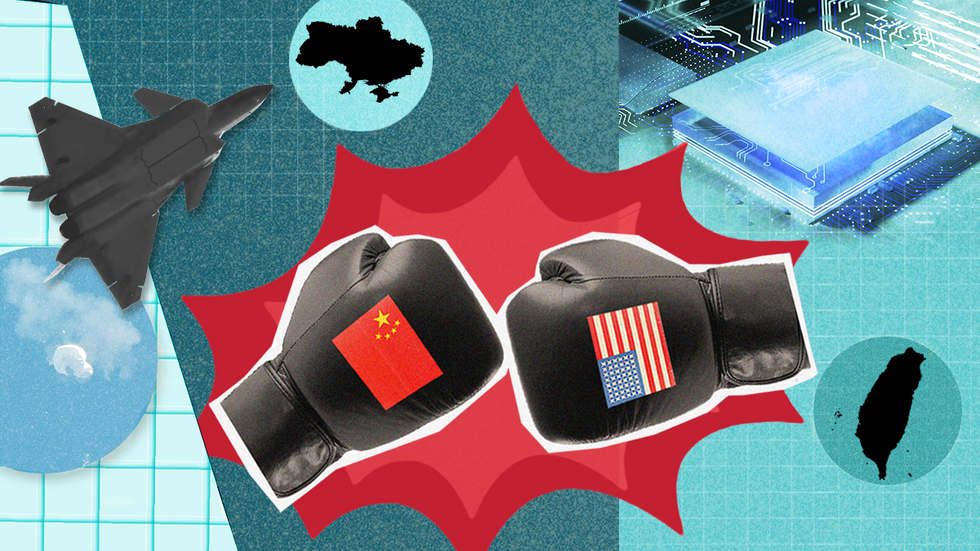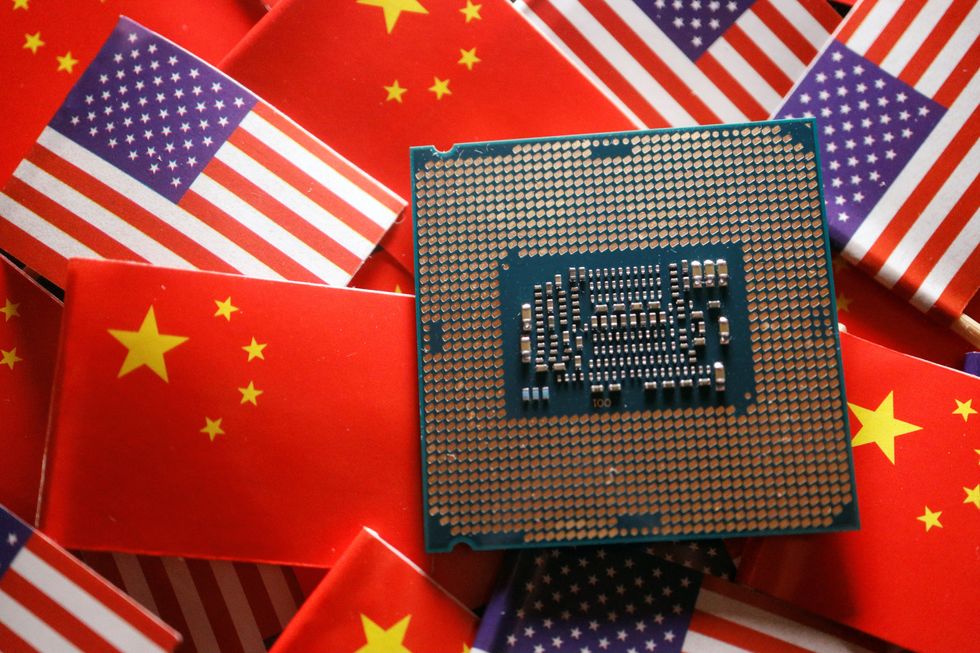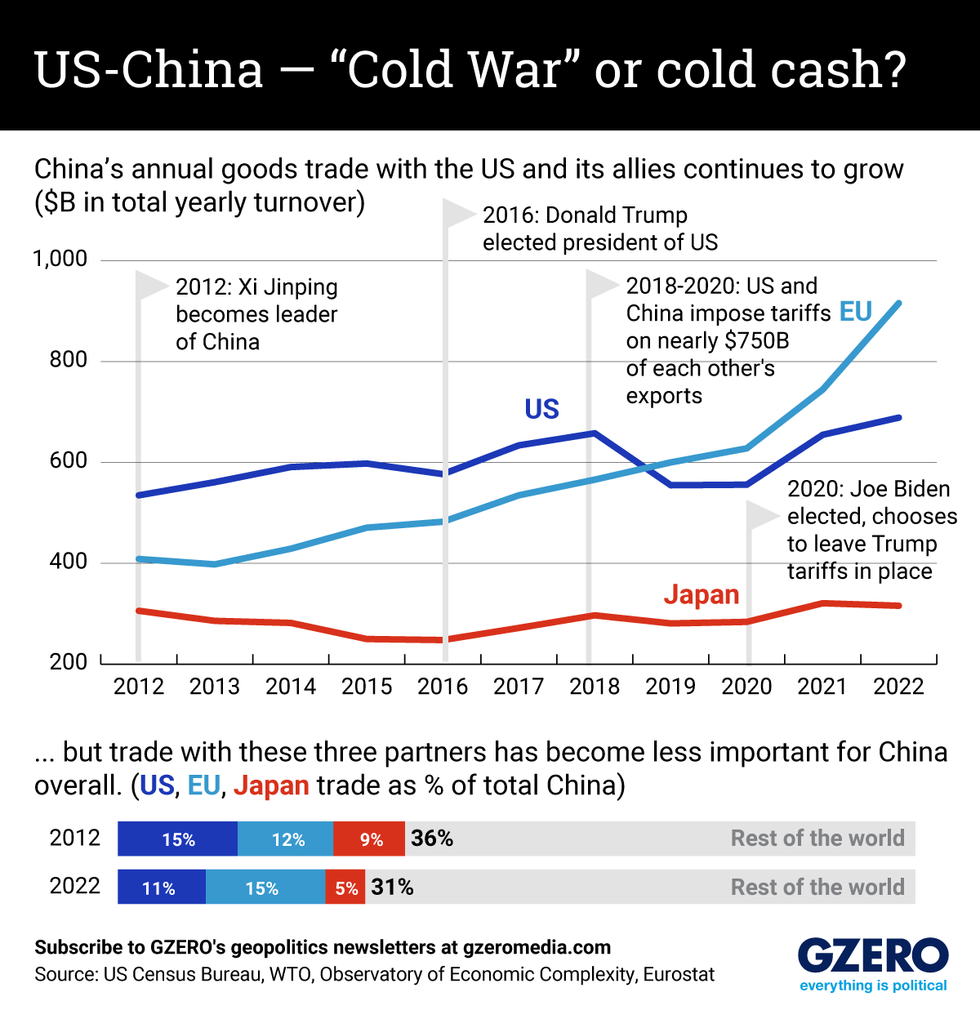Things are a bit frosty between the US and China these days. Whether it’s over who’s winning the tech race, trade, Ukraine, or near mid-air military collisions, the frayed bilateral ties are fueling speculation of a US-China Cold War.
But in this special edition of GZERO Daily, in partnership with Citi Global Wealth Investments, we dispute that notion while also exploring various aspects of conflict and potential confrontation, including:
- The risk of a hot war over Taiwan
- China’s global trade patterns
- The impact on allies
- War games
- Plus: Listen up for where the US and China might find common ground.
Thanks for reading.
– The GZERO Daily team
The US-China Cold War fallacy?
 Willis Sparks
Willis SparksA steady stream of headlines today suggests that a metastasizing confrontation between China and the United States has put an end to what we’ve known as globalization, the flow of goods, services, and money across international borders at unprecedented speed and scale. We challenge that view.
It’s true that US-China relations have become more contentious than at any time since (at least) the Tiananmen Square massacre in 1989, and every time it appears things might improve, some new revelation or provocation has officials in Washington and Beijing threatening some new action. High tariffs between the two countries for all kinds of goods have remained in place for the past five years.
It’s also true that the US and China are fragmenting the flow of the globalized economy by remaking supply chains to reduce dependence on the other side for critical resources and products where they believe a shortage might threaten their national security. Yes, competition in the tech sector, especially for products like computer chips, has created an increasingly disruptive rivalry.
We also cannot ignore the reality that China’s President Xi Jinping has expressed some limited support for Russia and its president at a time when Russian forces occupy territory inside NATO-backed Ukraine and are killing Ukrainian civilians.
Washington and Beijing clearly have an increasingly contentious relationship that’s getting worse, and the globalization we’ve known over the past three decades is fragmenting in some ways.
And yet … did you know that US-China trade volumes set a record in 2022?
In the 10-plus years that Xi has ruled in China, the share of China’s exports headed for the United States, Europe, and Japan has barely moved at all. Whatever sympathy Xi has for Putin, he appears to believe that economic growth is crucial to the future of China – and its ruling party – and that economic growth depends on pragmatic relations with America and its most prosperous allies.
It’s crucial too that other wealthy countries continue to see the necessity of strong economic relations with China. US-friendly democracies in Europe, Japan, South Korea, Australia, and Canada remain closely aligned with Washington on security questions, but none of their leaders have taken action that suggests they believe China can be economically isolated as Russia has been.
In short, there is recognition in the United States, China, Europe, India, and every country that profits from a globalized economy that no one can afford a 20th-century-style division of the world into two blocs separated by a wall made hastily from cheap East German cement. Globalization may retreat for now into a surging number of regional trade deals, as we’ve seen over the past 15 years, but it has become too big to fail, and those in positions of power know the headlines don’t tell the full story.
That’s our assertion, but we’re also watching areas of the US-China conflict – and potential confrontation – that are genuinely disruptive. Have a look below and tell us what YOU think. Write to us here.
What We’re Watching: US-China tech race, fence-sitting friends, tensions over Taiwan

US-China tech “Cold War” is on
The best fallacies stem from kernels of truth. In the case of what is being framed by some as the US-China “Cold War,” that kernel lies in the tech sector, where competition between the world’s two largest economies is fierce. The Biden administration has been increasingly clear that it is intent on slowing down China’s technological rise, and has centered its efforts toward decoupling — a low-grade form of economic warfare.
The rivalry has been bubbling for years, as US national security officials worried that Chinese tech firms were stealing intellectual property from American companies and data from US citizens. It spans from crucial sectors like software and semiconductors, where the US is fighting to maintain its competitive advantage, to industries like electric vehicles, smartphones, and drones, where China has the edge (maybe AI too).
China’s technological rise can be attributed to its skilled and lower-cost workforce and its ability to subsidize domestic companies and push out Western rivals. As a result, Chinese companies lead the world in smartphone sales, especially in Asia and Africa, and Huawei dominates the (non-Western) telecommunications sector.
Alarmed by the mounting competition, the Biden administration’s decoupling strategy has taken the form of tariffs, export controls, investment blocks, and visa limits. It has also put pressure on its allies to ban Huawei from the 5G networks. Washington has dramatically expanded its control over tech flowing to Beijing and imposed aggressive sanctions on China’s chip and semiconductor industry.
Yet, the costs of decoupling may outweigh the gains. It won’t cripple China’s tech sector, but merely “slows down China at the cost of hurting US companies at the same time,” says Eurasia Group expert Xiaomeng Lu.
One way the US-China tech race could acquire Cold War vibes is by creating a bipolar world where Chinese technology reigns supreme in Asian and African nations but is blocked from the West. The US weighing a TikTok ban is a step in this direction, and US tech giants like Twitter, Google, and Facebook are already unavailable in China.
What’s more, social media is likely only the first step of the US-China decoupling. In 2020, the State Department launched a plan to block out any connection to China, including telecommunications networks, mobile apps, cloud services, and even the undersea cables that carry web data between nations.
Most of the world prefers not to choose
As the US-China rivalry deepens, many countries – including close US allies – have made it clear that they don’t want to be forced to choose between the world’s two largest economies. They are engaging in an increasingly delicate dance to try and maintain constructive relations with both.
This tricky balancing act has been particularly hard for European heavyweights, like Germany and France, that share values and many interests with Washington, but also benefit greatly from economic integration with China.
While France’s Emmanuel Macron has taken a more combative approach, saying recently that it would be “a trap for Europe” to get embroiled in crises “that aren’t ours,” German Chancellor Olaf Scholz vigorously defended a recent trip to Beijing with a host of German business leaders, writing that “we don’t want to decouple from China.” (It’s no wonder that Berlin won't roll over on this issue considering that German exports to China have tripled since 2000.)
And what about countries in the Global South that are being wooed by both the US and China? Many countries across South America, Africa, and Central and South Asia benefit from loans and infrastructure investment under Beijing’s Belt and Road Initiative but also rely on the US for security guarantees and aid. Since Beijing expanded its Belt and Road Initiative to Latin America in 2017, the US has tried to warn that it is a Trojan Horse aimed at increasing China’s regional clout, but Argentina, Chile, Ecuador, and others have still tried to play both sides.
For now, this approach seems to be working, but if tensions over Taiwan ratchet up, it could get harder for US allies to continue fence-sitting.
US vs. China in Taiwan
The US and China may not be in a Cold War — but they could end up fighting a hot war over Taiwan.
For many, the question is not if but when Xi Jinping will decide to invade the self-ruled island. Maybe 2025, especially if a pro-independence candidate wins Taiwan's presidential election next year and the US president is distracted by messy domestic politics. Another option is 2027, when Xi has told the Chinese military to be ready to attack. Or perhaps he will just kick the can down the road until his final deadline, 2049, when the People’s Republic turns 100.
Regardless, annexing Taiwan by force would be a huge gamble for China.
For one thing, Xi knows that no matter how much China boosts defense spending, its military has not been tested in combat since 1979, when it — checks notes — lost a border war with Vietnam. For another, China's leader is probably having second thoughts after the Western response to Russia's war in Ukraine.
What's more, the US is treaty-bound, under the 1979 Taiwan Relations Act, to help Taiwan defend itself. (Not defend Taiwan, whatever President Biden says.) But getting weapons to Taiwan under China's nose will risk direct conflict with US forces, potentially triggering World War III.
Finally, if you think the war in Ukraine did a number on the global economy, a US-China fight over Taiwan would be much worse. The island is a chipmaking superpower, and the potential hit to global supply chains is uncharted territory.CIO Strategy Webcast Series
 Citi Global Wealth Investments
Citi Global Wealth InvestmentsJoin us each week on Thursday at 11:30am EST for a conversation with senior investment professionals and external thought leaders on timely market events and ask your most pressing questions.
The Graphic Truth

Whether the US and China are in fact slouching towards a new “Cold War” or not, one thing is certain: Commerce between them is still hotter than ever.
In the 10 years since Xi Jinping took power as China’s leader, trade volumes between the world’s top two economies have continued to grow. The same is true of Chinese trade with key US allies like the EU and, to a lesser extent, Japan.
In fact, US-China trade has continued to rise despite the Great US-China Trade War of 2018-2020, when the Trump administration and Beijing slapped tariffs on some $730 billion of each other’s goods. In 2022, US-China trade reached a dizzying record high of $689 billion. For comparison with the actual Cold War — US-Soviet trade throughout the entire 1980s amounted to less than $50 billion.
That said, while overall trade continues to rise between China on one side and the US and its allies on the other, this trade is steadily becoming less important as a part of China’s overall global commerce. That is, China is relying ever more on trade with the rest of the world, and less on Uncle Sam and friends.
To show what that looks like, we track China’s trade with the US, EU, and Japan, and look at how that has figured into China’s total trade between 2012 and now.
A Cold War may come one day, but for now, cold cash is still king.
Hard Numbers: South China Sea war games, Chinese sour on America, US chipmaking labor shortage, Ya Ya breaks the internet
 Carlos Santamaria
Carlos Santamaria24: In a recent war game run by Chinese military planners, 24 hypersonic anti-ship missiles were able to sink the USS Gerald R. Ford, the US Navy’s newest aircraft carrier, every single time in 20 simulated battles. In the exercise, the US fleet is attacked after ignoring Chinese warnings not to approach a China-claimed island in the disputed South China Sea.
70,000-90,000: The US CHIPS Act is pouring billions of dollars into bringing semiconductor factories back to American soil to counter China. But, who will make the chips? According to one estimate, the US chipmaking industry faces a shortage of between 70,000 and 90,000 workers (engineers and technicians) in the coming years.
12.2: Only 12.2% of Chinese people “like” the United States, according to a new survey about views on national security by Tsinghua University, Xi Jinping's alma mater. The most popular country is Russia (54.8%) and the least, India (8%).
230 million: China's superstar giant panda Ya Ya finally returned to Beijing this week after 20 years at the Memphis Zoo in the US. Ya Ya, whose troubled journey encapsulates the current state of US-China ties, has become such an internet sensation among patriotic Chinese that a hashtag following her homecoming got 230 million views on Weibo, China's answer to Twitter.Listen up: Can the US and China find common ground?

In this episode of Living Beyond Borders, a podcast produced in partnership between GZERO Media and Citi Global Wealth Investments, we bring you the expert take on US-China relations.
With competing motivations, the superpowers are looking to protect themselves from each other … but they’re also intertwined. David Bailin, chief investment officer at Citi Global Wealth, and Eurasia Group and GZERO President Ian Bremmer unpack the delicate US-China balancing act.
This edition of GZERO Daily was written by Riley Callanan, Gabrielle Debinski, Alex Kliment, Carlos Santamaria, and Willis Sparks. Art by Annie Gugliotta, graphic by Ari Winkleman. Edited by Tracy Moran.
